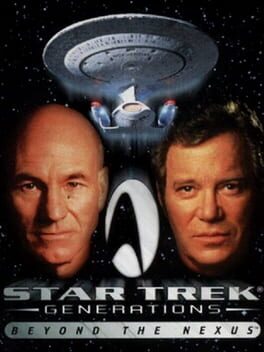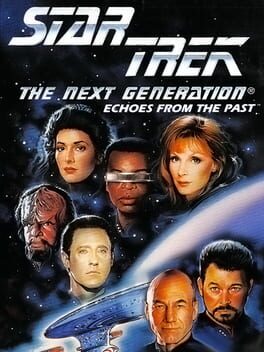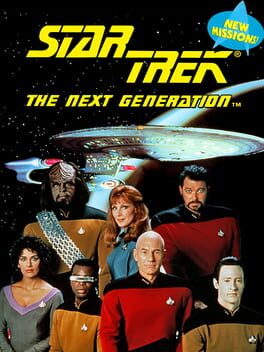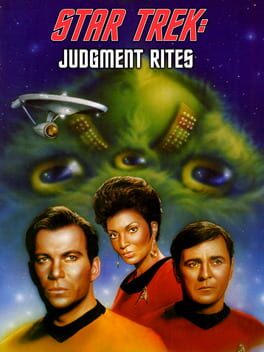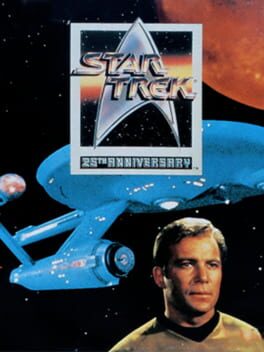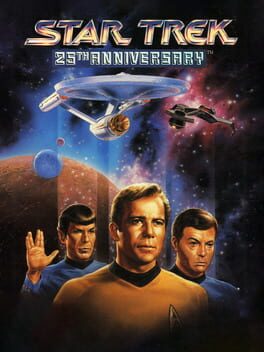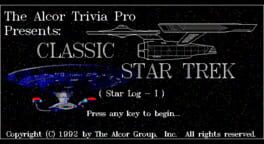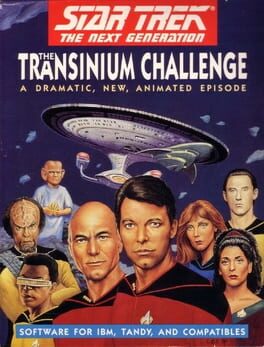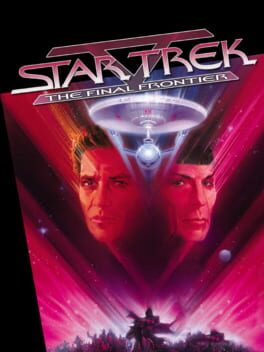Cube1701
The missions of this are similar to the SNES game. It was made for the Sega 32X add-on for the Mega Drive. The biggest difference for this is the graphics, which look much cleaner and less pixelated and the 3D models have a lot more texture and detail to them.
Playing this game on a standard 3-button Mega Drive controller is a nightmare as you need to press combinations for basic features, but the 6-button is good – although using the face buttons to tilt instead of shoulder buttons isn’t as intuitive (that said, you rarely need to do it). The one thing I couldn’t work out to do is how to pause the game.
Another addition to this version is pool, which you can play against your fellow cadets (or a second player). There’s not really a lot to it, it’s just a standard top down pool game.
The control nitpicks aside, this is a really nice version of the game. The wider screen gives a bigger view. The bridge itself looks more like an actual starship bridge rather than the more video game look of the SNES one.
Playing this game on a standard 3-button Mega Drive controller is a nightmare as you need to press combinations for basic features, but the 6-button is good – although using the face buttons to tilt instead of shoulder buttons isn’t as intuitive (that said, you rarely need to do it). The one thing I couldn’t work out to do is how to pause the game.
Another addition to this version is pool, which you can play against your fellow cadets (or a second player). There’s not really a lot to it, it’s just a standard top down pool game.
The control nitpicks aside, this is a really nice version of the game. The wider screen gives a bigger view. The bridge itself looks more like an actual starship bridge rather than the more video game look of the SNES one.
I was quite impressed by this game. It’s a series of 20 simulations (plus some bonus ones) where you command a team of Starfleet Academy students. The main buttons are used for flying (thankfully you can turn off inverted controls) and weapons, with the L and R buttons being used to spin the ship, which is more control than previous games. Press the select button and the viewscreen will bring up a menu where you can give commands to your crew – sensors, red alert, hailing and things like that.
The missions start off with little focus on combat, one has you moving a radioactive asteroid from the planet, the most interesting one has you investigate a protostar which ends up with contact with a new species, others have you investigate missing/destroyed ships. A few of them let you complete your objective and leave an area without defeating the enemies there.
Each mission concludes with the lesson it was built to teach, and will also give you a score based on your performance, telling you anything you did wrong (I kept forgetting to cancel red alert when going back to starbase). If you fail and get a score of zero, you’re supposed to carry on finishing the current set of 5 missions and redoing all of them if you don’t reach 75% (or just use the passwords to reload the mission – which makes it strange that it isn’t just an option).
After you complete the 20 missions you get your final mission: deliver some supplies. When you start, you get hailed by a ship called the Kobayashi Maru, which is losing power but has stranded into the neutral zone. I was surprised that you aren’t forced into combat and I was able to choose the option of getting higher ups to ask the Klingons to help, as I don’t think the mission is worth starting a war over. You can also enter codes in the character creation (it’s just male/female and some pre-set names) to unlock names. If you play as James T. Kirk, you get to play an alternate version of the test.
While the later mission are mores combat focused, which still feels a bit clunky as you can only fire directly forwards, I found it to be a mostly enjoyable game. It also has some very early 3D, and they’ve done well with the limited resources of the SNES.
The missions start off with little focus on combat, one has you moving a radioactive asteroid from the planet, the most interesting one has you investigate a protostar which ends up with contact with a new species, others have you investigate missing/destroyed ships. A few of them let you complete your objective and leave an area without defeating the enemies there.
Each mission concludes with the lesson it was built to teach, and will also give you a score based on your performance, telling you anything you did wrong (I kept forgetting to cancel red alert when going back to starbase). If you fail and get a score of zero, you’re supposed to carry on finishing the current set of 5 missions and redoing all of them if you don’t reach 75% (or just use the passwords to reload the mission – which makes it strange that it isn’t just an option).
After you complete the 20 missions you get your final mission: deliver some supplies. When you start, you get hailed by a ship called the Kobayashi Maru, which is losing power but has stranded into the neutral zone. I was surprised that you aren’t forced into combat and I was able to choose the option of getting higher ups to ask the Klingons to help, as I don’t think the mission is worth starting a war over. You can also enter codes in the character creation (it’s just male/female and some pre-set names) to unlock names. If you play as James T. Kirk, you get to play an alternate version of the test.
While the later mission are mores combat focused, which still feels a bit clunky as you can only fire directly forwards, I found it to be a mostly enjoyable game. It also has some very early 3D, and they’ve done well with the limited resources of the SNES.
A game loosely based on Star Trek Generations. It uses the Advanced Holodeck Tutorial as a basis and adds more modes (although more minigames) to kind of tell the story. It starts off on the Enterprise B on it’s maiden voyage when it suddenly gets attacked by Tholians.
The ship combat is a very simplified version of the previous game. There’s no commands to give anyone, just turn and shoot. It’s also much easier as you rarely get hit, but combat still drags on. After this, you need to track a distress call by playing a minigame similar to Mastermind where you enter symbols and the game tells you how many are the correct symbol and how many are in the right place. The third minigame has you flying through squares, with another involving you laying down pipes. After doing a few of these a few times, the game cuts forward to the Enterprise D, skipping Kirk’s apparent death.
The Enterprise D section follows the same minigames, and adds some basic top-down on foot-sections where you shoot enemies as you run to Soren. You do a few at Amargosa Station, track the Klingon Bird of Prey, do a few more, blow up the Bird of Prey and get a message saying that the Enterprise had to crash on the planet but everyone is saved. Considering the game is called “Beyond the Nexus”, there’s nothing actually involving the Nexus.
However, you do get a screen saying that there’s a hidden final level, but can only access if you can name the ship that rescued the crew at the end of the film. This last mission is just another code breaking minigame followed by a final still of Picard and the description of “The Body of James T Kirk is laid to rest”, even though he’s not been mentioned since he fixed something on the Enterprise B.
Beyond the Nexus is a very easy minigame collection that poorly tells the story of Star Trek Generations. The most disappointing thing is that the Generations theme music isn’t even in the game.
There’s also a Game Boy version which is the exact same game but with fewer colours (it supports colour for the Super Game Boy, but still not as advanced as the Game Gear version).
The ship combat is a very simplified version of the previous game. There’s no commands to give anyone, just turn and shoot. It’s also much easier as you rarely get hit, but combat still drags on. After this, you need to track a distress call by playing a minigame similar to Mastermind where you enter symbols and the game tells you how many are the correct symbol and how many are in the right place. The third minigame has you flying through squares, with another involving you laying down pipes. After doing a few of these a few times, the game cuts forward to the Enterprise D, skipping Kirk’s apparent death.
The Enterprise D section follows the same minigames, and adds some basic top-down on foot-sections where you shoot enemies as you run to Soren. You do a few at Amargosa Station, track the Klingon Bird of Prey, do a few more, blow up the Bird of Prey and get a message saying that the Enterprise had to crash on the planet but everyone is saved. Considering the game is called “Beyond the Nexus”, there’s nothing actually involving the Nexus.
However, you do get a screen saying that there’s a hidden final level, but can only access if you can name the ship that rescued the crew at the end of the film. This last mission is just another code breaking minigame followed by a final still of Picard and the description of “The Body of James T Kirk is laid to rest”, even though he’s not been mentioned since he fixed something on the Enterprise B.
Beyond the Nexus is a very easy minigame collection that poorly tells the story of Star Trek Generations. The most disappointing thing is that the Generations theme music isn’t even in the game.
There’s also a Game Boy version which is the exact same game but with fewer colours (it supports colour for the Super Game Boy, but still not as advanced as the Game Gear version).
This game is heavily based on Future’s Past, but considering they both came out only a few months apart, there are a surprising amount of differences.
The game starts off with a lovely pixelated recreation of the opening of The Next Generation, which makes it feel even more like an episode of the show. There’s also a lot more dialogue in this game as the characters you meet have conversations with Picard instead of just a single paragraph at the end. Missions are mostly the game, but with slightly different layouts that make things look slightly more like actual locations, although they’re still difficult mazes. Using items is more fiddly due to the lack of shoulder buttons.
The combat is mostly the same, but ships seem to move a lot faster. This causes the sensor grid to zoom in an out a lot, which I found to be extremely nauseating. If you can put up with that, I do recommend this version due to the improved dialogue – with the exception of one change where the mission is something given to Picard and not the crew (the objective recaps now take place in the ready room instead of the briefing room).
The game starts off with a lovely pixelated recreation of the opening of The Next Generation, which makes it feel even more like an episode of the show. There’s also a lot more dialogue in this game as the characters you meet have conversations with Picard instead of just a single paragraph at the end. Missions are mostly the game, but with slightly different layouts that make things look slightly more like actual locations, although they’re still difficult mazes. Using items is more fiddly due to the lack of shoulder buttons.
The combat is mostly the same, but ships seem to move a lot faster. This causes the sensor grid to zoom in an out a lot, which I found to be extremely nauseating. If you can put up with that, I do recommend this version due to the improved dialogue – with the exception of one change where the mission is something given to Picard and not the crew (the objective recaps now take place in the ready room instead of the briefing room).
This one took a bit of getting used to due to some fiddly buttons and confusing menus. The Enterprise is monitoring Romulan Activity in the Neutral Zone and ends up in an epic quest to be chosen to be given an extremely powerful weapon – one that the Romulans and a new race called the Chodak.
The game starts off with a view of the Enterprise D bridge. Here you look around at the various stations. Some (like the Computer and Sensors) give you additional information, the Briefing Room has Picard explain the current objective to the crew (a really nice touch) and the main one – the conn lets you set a course. There are a lot of places to choose from, although there’s not much reason to visit most, not to mention that the game bugs you if you’re not doing the current objective.
While at warp, you may randomly encounter enemy ships. The focus on ship combat is a top-down view and is very basic and quite annoying. You’re also supposed to keep an eye out for a little notification that the enemy ship is surrendering (although there’s no penalty for blowing them up). When you get damaged, your ship’s systems will go down and you’ll have to assign resources to each one. You can go to a starbase to completely repair (which also creates a password to save the game), but I found that as most of the game it was navigation or engines that were down, you just had to leave the game for a few minutes and let the admiral yell at you for not doing the current objective.
When you go on an away mission, you get to pick your away team (in most cases). You’ll want to take Data on every possible mission as he has the best stats and can see in the dark, which is the only ability that makes a difference (and only on one mission). Some crew completely lack phasers (like Dr. Crusher). I found myself using Data, La Forge, Worf and a random ensign on most missions.
These missions involve a lot of shooting, some puzzle solving and a lot of aimlessly walking around the maze-like levels. There’s some interesting ideas here, as you can swap between the away team and take them separate routes or command them to follow one person.
I feel like a sequel for this could have had the potential to fix the issues with this game. There’s some good ideas, but ultimately isn’t executed very well.
The game starts off with a view of the Enterprise D bridge. Here you look around at the various stations. Some (like the Computer and Sensors) give you additional information, the Briefing Room has Picard explain the current objective to the crew (a really nice touch) and the main one – the conn lets you set a course. There are a lot of places to choose from, although there’s not much reason to visit most, not to mention that the game bugs you if you’re not doing the current objective.
While at warp, you may randomly encounter enemy ships. The focus on ship combat is a top-down view and is very basic and quite annoying. You’re also supposed to keep an eye out for a little notification that the enemy ship is surrendering (although there’s no penalty for blowing them up). When you get damaged, your ship’s systems will go down and you’ll have to assign resources to each one. You can go to a starbase to completely repair (which also creates a password to save the game), but I found that as most of the game it was navigation or engines that were down, you just had to leave the game for a few minutes and let the admiral yell at you for not doing the current objective.
When you go on an away mission, you get to pick your away team (in most cases). You’ll want to take Data on every possible mission as he has the best stats and can see in the dark, which is the only ability that makes a difference (and only on one mission). Some crew completely lack phasers (like Dr. Crusher). I found myself using Data, La Forge, Worf and a random ensign on most missions.
These missions involve a lot of shooting, some puzzle solving and a lot of aimlessly walking around the maze-like levels. There’s some interesting ideas here, as you can swap between the away team and take them separate routes or command them to follow one person.
I feel like a sequel for this could have had the potential to fix the issues with this game. There’s some good ideas, but ultimately isn’t executed very well.
When I first saw the name, I though it was a strange way of downplaying a game to make it sound not so good. But after playing the NES and Game Boy versions of this game (which didn’t have the subtitle), it’s actually a pretty fair description for the game.
The Game Gear version of this features a little splash screen explaining that it’s training missions on a holodeck at Starfleet Academy (that information was only in the manuals for the other versions), as well as some nice shots of the Enterprise D going to warp, with better use of colour throughout the game.
While the game still isn’t good, the Game Gear version is definitely the best version of it.
The Game Gear version of this features a little splash screen explaining that it’s training missions on a holodeck at Starfleet Academy (that information was only in the manuals for the other versions), as well as some nice shots of the Enterprise D going to warp, with better use of colour throughout the game.
While the game still isn’t good, the Game Gear version is definitely the best version of it.
By far the most impressive thing about this game is how they’ve managed to fit so much stuff on just a D-pad, A, B, Select and Start. The controls aren’t good by any stretch, it’s just impressive that they could do so much with so few buttons.
In this, you command the crew of the Enterprise D. Well, four of them at least. Worf will turn on/off shields and weapons. Data will set courses for systems and orbit planets. La Forge will boost power to some systems and sort out repairs. O’ Brian is the most involved with controlling the transporter. Riker tells you the time. You use the D-pad to select who you want to give a command to and A to confirm.
Pressing the select button will put you in a mode where you fly the ship and shoot phasers/torpedoes. However, to change speed you have to go back to the command mode and press forward/back.
The game itself is random missions that generally involve flying somewhere, shooting stuff and then transporting. It’s a fairly dull combat simulator and not much more. When you beam stuff up (cargo or hostages), you get a nice little minigame, but that’s all there is.
In this, you command the crew of the Enterprise D. Well, four of them at least. Worf will turn on/off shields and weapons. Data will set courses for systems and orbit planets. La Forge will boost power to some systems and sort out repairs. O’ Brian is the most involved with controlling the transporter. Riker tells you the time. You use the D-pad to select who you want to give a command to and A to confirm.
Pressing the select button will put you in a mode where you fly the ship and shoot phasers/torpedoes. However, to change speed you have to go back to the command mode and press forward/back.
The game itself is random missions that generally involve flying somewhere, shooting stuff and then transporting. It’s a fairly dull combat simulator and not much more. When you beam stuff up (cargo or hostages), you get a nice little minigame, but that’s all there is.
The sequel to the 25th Anniversary doesn’t get as much attention as the original, which is a shame as this is an improvement in every way.
Judgement Rites features an arching storyline trying most of the plots of each “episode” together, which I think works well for a video game. Each episode still feels like a complete story with its own individual plot, mysteries and setting. The away team also varies, so it’s nice that the rest of the crew (other than Spock and McCoy) get to do more in this game. This game was also the last completed project that had all of the main cast in it.
Combat returns, but now has an easier setting or can be disabled completely, although some dialogue is cut if you choose this. That said, some of the battles do just seem to be there for the sake of having a battle in each story, so it’s still good that you can turn off its weakest element.
The point and click portions are great, and there are no timers to worry about each time so you can solve them at your own pace. I did find a few times that some elements you need can be difficult to notice, for one story I was wondering around for ages because I didn’t realise that one computer panel was actually two (you needed to interact with both) and sometimes you won’t realise that the bottom of the screen is a path, but for the most part it’s solvable without really obscure solutions and sometimes there are even a couple of ways to do something.
Judgement Rites is a great game, and I highly recommend it.
Judgement Rites features an arching storyline trying most of the plots of each “episode” together, which I think works well for a video game. Each episode still feels like a complete story with its own individual plot, mysteries and setting. The away team also varies, so it’s nice that the rest of the crew (other than Spock and McCoy) get to do more in this game. This game was also the last completed project that had all of the main cast in it.
Combat returns, but now has an easier setting or can be disabled completely, although some dialogue is cut if you choose this. That said, some of the battles do just seem to be there for the sake of having a battle in each story, so it’s still good that you can turn off its weakest element.
The point and click portions are great, and there are no timers to worry about each time so you can solve them at your own pace. I did find a few times that some elements you need can be difficult to notice, for one story I was wondering around for ages because I didn’t realise that one computer panel was actually two (you needed to interact with both) and sometimes you won’t realise that the bottom of the screen is a path, but for the most part it’s solvable without really obscure solutions and sometimes there are even a couple of ways to do something.
Judgement Rites is a great game, and I highly recommend it.
Another game for the 25th Anniversary, and another one with its own story with its own version of the episode “The Doomsday Machine”. The Doomsday Machine is heading for Federation space. The Federation built a superweapon to destroy it, but the Klingons stole and split it into 12 parts on three planets. You have to find the pieces and destroy The Doomsday Machine.
In the space sections of the game, you have a map of the area and you can essentially choose which obstacles you face: asteroids, Klingons, Romulans, Tholians or Space Amoebas. These take you into a 2D scrolling thing where they all function the same with minor differences. You move to the right, avoiding and blasting obstacles. The Tholians are the most difficult due to their “webs”. Repeat this for the area until you reach the planet. There are four sections like this.
Once you reach a planet, you land on what looks like a randomly generated jumbled mess, but the layout is the same each time. You need to navigate these mazes, looking at your tricorder for directions, to collect four parts of the weapon. There are also enemies that are best avoided. You can shoot them, but if you run out of phaser energy you can soft-lock the game and have to die or restart the level.
This is a pretty terrible game. The space sections are fine but get repetitive before you finish the first one, and the ground sections are just a horrible mess.
In the space sections of the game, you have a map of the area and you can essentially choose which obstacles you face: asteroids, Klingons, Romulans, Tholians or Space Amoebas. These take you into a 2D scrolling thing where they all function the same with minor differences. You move to the right, avoiding and blasting obstacles. The Tholians are the most difficult due to their “webs”. Repeat this for the area until you reach the planet. There are four sections like this.
Once you reach a planet, you land on what looks like a randomly generated jumbled mess, but the layout is the same each time. You need to navigate these mazes, looking at your tricorder for directions, to collect four parts of the weapon. There are also enemies that are best avoided. You can shoot them, but if you run out of phaser energy you can soft-lock the game and have to die or restart the level.
This is a pretty terrible game. The space sections are fine but get repetitive before you finish the first one, and the ground sections are just a horrible mess.
While this shares the same name as the MS DOS game, this is not a console port of the 25th Anniversary. This is a completely different game, with its own gameplay, levels and even story. The story is fairly simple: The Enterprise has fallen though gravitational anomaly and ended up in an unknown region of space. They have to find dilithium crystals and make their way back home.
The game starts off pretty terribly. It feels like a shooter and exploring the first area you’ll be shot at by plants and probably killed by tiny worms. Once you figure out the game properly, there’s actually not that much shooting involved at all beyond the first level, instead the game is about exploring, finding items and working out how to use them.
Once you finish the rather tedious first level, you’re given a lot of planets to explore. Most of these are ones you either can’t land on or are just empty worlds, but it still gives the impression of a bigger world – a lot of planets are just bits of rock, after all, only a few planets contain missions that further the game. One of these is a really fun level set on a planet of rogue traders. There’s even a time travel mission where you have to save a planet that was destroyed due to the actions of Dr. McCoy.
While it has a very rough start, this surprisingly becomes quite enjoyable.
The game starts off pretty terribly. It feels like a shooter and exploring the first area you’ll be shot at by plants and probably killed by tiny worms. Once you figure out the game properly, there’s actually not that much shooting involved at all beyond the first level, instead the game is about exploring, finding items and working out how to use them.
Once you finish the rather tedious first level, you’re given a lot of planets to explore. Most of these are ones you either can’t land on or are just empty worlds, but it still gives the impression of a bigger world – a lot of planets are just bits of rock, after all, only a few planets contain missions that further the game. One of these is a really fun level set on a planet of rogue traders. There’s even a time travel mission where you have to save a planet that was destroyed due to the actions of Dr. McCoy.
While it has a very rough start, this surprisingly becomes quite enjoyable.
With very impressive production values, not only does this have a great visual style, but it’s also fully voiced with the full cast of The Original Series. It’s a point and click adventure game much closer to the likes of Monkey Island than previous games, which is a style that suits Star Trek extremely well
25th Anniversary comprises of 7 missions, which all feel like they could have been original episodes, with some interesting stories and some returning characters, and one is even a sort of prequel to Wrath of Khan. Although I did find that slightly odd because it starts with a Federation facility with a virus outbreak that only affected Romulans, with Spock saying it should be safe for everyone to beam over. I thought this was strange because of the link between Romulans and Vulcans and, sure enough, Spock gets ill, creating a timer for this mission (something I don’t like in games like this, I like slowly investigating everything). That said, the main parts of the mission are overall great.
Throughout the game you also get involved in ship combat. These parts of the game are horrible to control and are frustrating. The game would be better off with a simpler system where you give commands to your crew. One particularly annoying one involves a cloaked ship and you just have to hope that they don’t cloak too much to recharge shields – some of these battles are overly long.
Overall, 25th Anniversary is a really good Star Trek game, and it would be really nice to see a refreshed version that changes the ship combat and fixes some annoyances (like silencing repeated voice lines).
25th Anniversary comprises of 7 missions, which all feel like they could have been original episodes, with some interesting stories and some returning characters, and one is even a sort of prequel to Wrath of Khan. Although I did find that slightly odd because it starts with a Federation facility with a virus outbreak that only affected Romulans, with Spock saying it should be safe for everyone to beam over. I thought this was strange because of the link between Romulans and Vulcans and, sure enough, Spock gets ill, creating a timer for this mission (something I don’t like in games like this, I like slowly investigating everything). That said, the main parts of the mission are overall great.
Throughout the game you also get involved in ship combat. These parts of the game are horrible to control and are frustrating. The game would be better off with a simpler system where you give commands to your crew. One particularly annoying one involves a cloaked ship and you just have to hope that they don’t cloak too much to recharge shields – some of these battles are overly long.
Overall, 25th Anniversary is a really good Star Trek game, and it would be really nice to see a refreshed version that changes the ship combat and fixes some annoyances (like silencing repeated voice lines).
This trivia game has a lot more features than the previous ones. The major one is multiplayer, where people take turns answering questions to compete for a high score. There are quite a few options to choose from, such as number of players, number of questions, timers, if the game reveals the correct answer if you get it wrong and “casino rules” where you can bet a portion of points that you’ll get the next question right.
The questions are all based on The Original Series. Some are about the episode, some are about the production (one was for the budget of The Cage, with four very similar numbers as options). I did notice one slight error: when asked about what division wears red shirts, Engineering was apparently wrong (it said security, which is also correct).
The questions are all based on The Original Series. Some are about the episode, some are about the production (one was for the budget of The Cage, with four very similar numbers as options). I did notice one slight error: when asked about what division wears red shirts, Engineering was apparently wrong (it said security, which is also correct).
This one is pretty terrible. While previous DOS games have had nice graphics, this one wanted to have animation so much that it opted for extremely ugly graphics in order to do so. The animations are bizarre, too, mostly consisting of Riker looking around confused.
Riker has been put in charge of the Enterprise. Picard is still there and the game would have been no different if you played as the Captain instead, so I’m not entirely sure why you play as Riker. None of the character’s personalities come out in the writing anyway. Riker’s mission is to stop some terrorist attacks.
To get things done, you have to continuously talk to people waffle on about nothing important, wander around a bit and chase ships around by moving between planets and asteroids because their position is random. The game is mainly boring, repetitive tasks. While the text-based games have quite big stories, this one feels like it would just be the cold opening of an episode.
This game also has combat with a turn-based mechanics where you can evade, shoot or alter position. It would be interesting to try it properly, but there’s only one fight in the game and the enemy ship keeps running away, requiring you to randomly check locations so you can fight it again.
Riker has been put in charge of the Enterprise. Picard is still there and the game would have been no different if you played as the Captain instead, so I’m not entirely sure why you play as Riker. None of the character’s personalities come out in the writing anyway. Riker’s mission is to stop some terrorist attacks.
To get things done, you have to continuously talk to people waffle on about nothing important, wander around a bit and chase ships around by moving between planets and asteroids because their position is random. The game is mainly boring, repetitive tasks. While the text-based games have quite big stories, this one feels like it would just be the cold opening of an episode.
This game also has combat with a turn-based mechanics where you can evade, shoot or alter position. It would be interesting to try it properly, but there’s only one fight in the game and the enemy ship keeps running away, requiring you to randomly check locations so you can fight it again.
If you don’t remember a NES game based on The Final Frontier, you’re not going crazy: this game was cancelled and was never released. A four state prototype was discovered so we can see what the game would look like.
Like a lot of movie-based games, this is a side scrolling shooter. You start off as Sulu as he fights his way through Paradise. It has the difficulty you would expect from a NES movie tie-in game, with lots of projectiles flying in arcs. That said, this isn’t as frustrating as most of them. This first level is a pretty basic kill enemies and move to the right level.
Next you play as Scotty in a more open level. You need to find enemies that have bombs in order to collect them, the objective being blowing up a door to get to Kirk, Spock and McCoy. If you travel down the level, there’s a section you can’t get back up without the aid of rocket boots.
The third level is an Enterprise level, and a terrible one due to the controls. You need to blow up asteroids and then a bird of prey.
Finally, you play as Kirk on the creation planet. This is another liner level, but has basic platforming segments that work just fine (a lot of movie tie-in NES games have terrible platforming mechanics). The aim is to get to and defeat the entity that Sybok (Spock’s former classmate) believes to be “Got” (no, I haven’t made any mistakes, this is what the text of the game says) with a boss fight at the end.
If this got finished, it would have been a decent (albeit frustrating) game. I think Bandai were aiming to create a level for each member of the crew.
Like a lot of movie-based games, this is a side scrolling shooter. You start off as Sulu as he fights his way through Paradise. It has the difficulty you would expect from a NES movie tie-in game, with lots of projectiles flying in arcs. That said, this isn’t as frustrating as most of them. This first level is a pretty basic kill enemies and move to the right level.
Next you play as Scotty in a more open level. You need to find enemies that have bombs in order to collect them, the objective being blowing up a door to get to Kirk, Spock and McCoy. If you travel down the level, there’s a section you can’t get back up without the aid of rocket boots.
The third level is an Enterprise level, and a terrible one due to the controls. You need to blow up asteroids and then a bird of prey.
Finally, you play as Kirk on the creation planet. This is another liner level, but has basic platforming segments that work just fine (a lot of movie tie-in NES games have terrible platforming mechanics). The aim is to get to and defeat the entity that Sybok (Spock’s former classmate) believes to be “Got” (no, I haven’t made any mistakes, this is what the text of the game says) with a boss fight at the end.
If this got finished, it would have been a decent (albeit frustrating) game. I think Bandai were aiming to create a level for each member of the crew.

